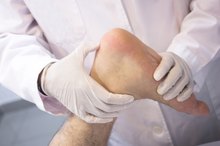Signs of a Bone Spur in Elbow
Bone spurs, or osteophytes, can form in the spine or in any joint. They usually form at the end of the bone. They can exist without causing any symptoms at all. Bone spurs themselves are not painful, but they can rub against or put pressure on surrounding tissue or nerves. Bone spurs can cause problems if they break off and lodge in the joint. If you notice symptoms suggestive of a bone spur talk to your doctor about treatment. There are medications to manage your symptoms. Your bone spur can also be surgically removed if the symptoms become severe.
If you are experiencing serious medical symptoms, seek emergency treatment immediately.
Pain
If your bone spur is large enough to place pressure on surrounding tissue, rub against another bone or compress a nerve, you may have elbow pain. It may be painful to straighten your arm and to perform repetitive motions such as throwing or swimming.
Loss of Motion
Signs & Symptoms of Shoulder Injuries
Learn More
Having a bone spur in your elbow can inhibit your elbow's ability to move. You may notice stiffness and a decrease in the range of motion in the elbow joint. In addition, you may experience tenderness, swelling and inflammation around the area of the spur.
Locking
The Mayo Clinic states that if the bone spur becomes loose it can cause a locking sensation in the elbow joint as you move. You may feel that you temporarily cannot move your elbow at all. As the bone spur moves within the joint space, you will be able to bend your elbow again.
Related Articles
References
Writer Bio
I hold a Master's degree in exercise physiology/health promotion. I am a certified fitness specialist through the American College of Spots Medicine and an IYT certified yoga teacher. I have over 25 years experience teaching classes to both general public and those with chronic illness. The above allows me to write directly to the reader based on personal experiences.








